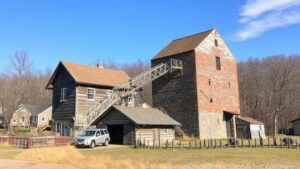Mining Old Timber Processing Plans for Logging Relic Hotspots
Mining Old Timber Processing Plans for Logging Relic Hotspots
This research article investigates the methodology and significance of utilizing old timber processing plans to identify and analyze logging relic hotspots. The essence of this study lies in understanding the historical context of timber harvesting and the resulting ecological implications, contributing to both the restoration of forestry practices and the conservation of historical resources.
Introduction
The logging industry has undergone substantial transformations since its inception in the late 19th century, catalyzed by technological advancements and evolving environmental regulations. Many historical timber processing plans, some dating back over a century, offer a wealth of information about past logging practices and their impacts on ecosystems. e plans indicate the locations of past logging operations, known as logging relic hotspots, which can reveal critical insights into both ecological patterns and historical land use.
The Historical Context of Timber Processing
Timber processing began in earnest during the industrial revolution, with significant progress observed in regions such as the Pacific Northwest of the United States. In 1900, approximately 6 billion board feet of timber were harvested annually, which soared to nearly 16 billion board feet by the 1950s, as reported by the U.S. Forest Service. rise of mechanized logging, coupled with inefficiencies in earlier processing plans, resulted in extensive alterations to the forest landscape.
Methodology of Mining Old Plans
This study employs a multi-step methodology for mining old timber processing plans:
- Data Collection: Acquire archival timber processing plans from state forestry departments and historical societies.
- Mapping Techniques: Use Geographic Information Systems (GIS) to geo-reference old timber plans and overlay them with current forest inventory data.
- Field Verification: Conduct site visits to logging relic hotspots identified in the GIS analysis for validating historical land use against current ecological conditions.
Case Study: The Olympic National Forest
The Olympic National Forest in Washington State serves as an exemplary case study. Archival documents reveal extensive logging operations from the 1920s to the 1980s, with significant implications for the biodiversity of the area. A 2020 assessment conducted by the Washington State Department of Natural Resources identified more than 30 logging relic hotspots within the forest, correlating these sites to declines in native species habitats.
Ecological Implications of Logging Relic Hotspots
Logging relic hotspots provide vital ecological data that can be utilized in conservation efforts. data suggest three primary ecological implications:
- Biodiversity Loss: Areas with historical logging practices often display decreased biodiversity, as species dependent on specific ecological conditions may not recover.
- Soil Erosion: Studies indicate that past logging significantly contributes to soil erosion, affecting watershed health.
- Invasive Species Proliferation: The disturbance from logging practices creates niches that allow invasive species to flourish, threatening local flora and fauna.
Real-World Applications
Understanding logging relic hotspots offers several practical applications in contemporary forestry management:
- Conservation Planning: Identifying areas at risk helps prioritize conservation efforts for restoration and protect remaining biodiversity.
- Public Education: Engaging communities in the restoration of these sites fosters awareness about the historical impacts of logging practices.
- Policy Development: Informing policymakers with data from these analyses encourages the establishment of regulations that advocate for sustainable forestry practices.
Conclusion
Mining old timber processing plans is a critical step toward understanding the ecological impacts of historical logging operations. By focusing on logging relic hotspots, ecologists and land managers can formulate strategies to mitigate adverse effects, restore habitats, and promote sustainable forestry. It is vital for stakeholders to recognize the value of historical data, as it provides an opportunity to learn from the past and guide future forestry practices.
Actionable Takeaways
In summary, stakeholders in forestry management and conservation can take the following actionable steps:
- Engage in partnerships with local historical societies for archival research.
- Employ GIS technology to visualize and analyze historical logging data alongside current ecological assessments.
- Advocate for restoration projects focused on identified logging relic hotspots to foster biodiversity and ecological health.
The integration of historical logging data into modern forestry practices is essential not only for preserving the environment but also for honoring the historical context of our natural resources.

